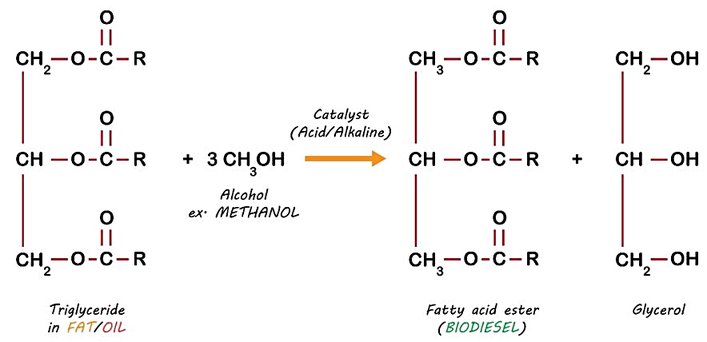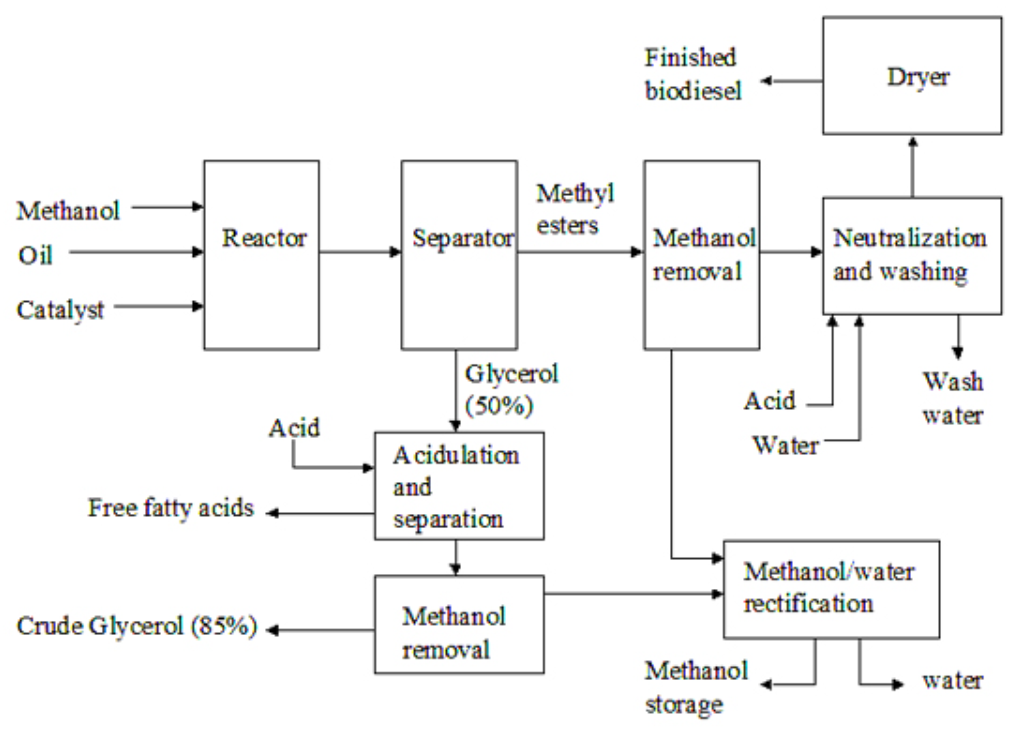Process Description[1]
Transesterification is the most widely employed process for commercial production of biodiesel. It involves heating the oil (lipids) to a designated temperature with alcohol and a catalyst, thereby restructuring its chemical structure (Fig. 1). This conversion reduces the high viscosity of the oils and fats.
Figure 1 - Transesterification of Triglycerides into Biodiesel[3]

For the transesterification of triglyceride (TG) molecule, three consecutive reactions are needed. In these reactions, the TG is displaced by the alcohol. one mole of glycerol and three moles of alkyl esters are produced (for each mole of TG converted) at the completion of the net reaction. These separate into three layers, with glycerol at the bottom, a middle layer of soapy substance, and biodiesel on top.
Transesterification is a reversible reaction. To obtain reasonable conversion rates therefore, it requires a catalyst. The reaction conditions, feedstock compositional limits and post-separation requirements are predetermined by the nature of the catalyst.
Transesterification techniques for biodiesel production include:
- homogeneous alkali-catalyzed transesterification
- Heterogeneous acid and base-catalyzed transesterification
- Enzymatic transesterification
- Supercritical alcohol transesterification
which may as well be microwave or ultrasound assisted.
Process Economics[2]
The following model is meant to be representative of an “average” plant constructed in 2007 to process soybean oil into biodiesel. There is certainly substantial variation in capacity, production efficiency, and feedstock across the industry and this should be kept in mind when viewing profit estimates from the model.
- 30 million gallons annual biodiesel production capacity.
- Plant construction cost of $1.57 per gallon of nameplate capacity.
- 50 percent debt and 50 percent equity financing.
- 8.25 percent interest on a 10-year loan for debt financing, with the loan paid off in 2017.
- Plant operates at 100 percent of nameplate capacity.
- Plant only processes soybean oil into biodiesel.
- 7.55 pounds of soybean oil feedstock used per gallon of biodiesel.
- 0.9 pounds of glycerin co-product per gallon of biodiesel.
- Seven cubic feet of natural gas per gallon of biodiesel.
- 0.8 pounds of methanol used per gallon of biodiesel.
- Other variable input costs of 25 cents per gallon of biodiesel.
- Total fixed costs of 26 cents per gallon of biodiesel through 2017 and 20 cents per gallon thereafter.
References
- Biodiesel, Chapter 4, Y.M. Sani, W.M.A.W. Daud and A.R. Abdul Aziz, 7 May 2012, Biodiesel Feedstock and Production Technologies: Successes, Challenges and Prospects.
- Maria Gerveni and Scott Irwin - Department of Agricultural and Consumer Economics - University of Illinois, Todd Hubbs - Economic Research Service - U.S. Department of Agriculture, 10 May 2023, The Biodiesel Profitability Squeeze, farmdoc daily (13):85.
- Sydney Casey, 24th May 2023, What is it - Transesterification, Mansfield Energy Corp.












